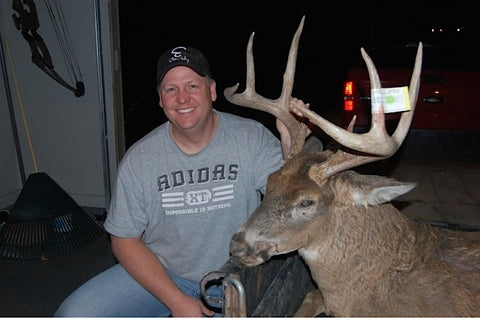Big Antlers Can Come In Small Packages
September 16 2014 – Shawn OConnor
The October issue of Iowa Sportsman magazine is out and we want to share our article, "Big Antlers Can Come In Small Packages".
Big things can come in small packages, but that only happens if you pay attention to the small stuff.
I’ve always dreamed of owning my own hunting property, but with raising a family, saving for college tuition's and putting aside a nest egg for retirement, I knew my dream property would be much smaller than most hunters would consider ideal. I worried that if I bought a smaller farm, it may fall short of my expectations or I may even regret purchasing it.
 Given the market conditions, I knew that I would need to look for 40 acres. Not exactly a lot of ground. What are the odds of killing a nice buck on 40 acres? Am I just wasting my time and money by buying such a small piece of land? Maybe I should partner with others to buy a larger piece of ground? All of these doubts kept my mind debating itself on what course of action to take.
Given the market conditions, I knew that I would need to look for 40 acres. Not exactly a lot of ground. What are the odds of killing a nice buck on 40 acres? Am I just wasting my time and money by buying such a small piece of land? Maybe I should partner with others to buy a larger piece of ground? All of these doubts kept my mind debating itself on what course of action to take.
Then one night I turned on The Sportsman Channel and glanced over at a program showcasing hunters on “suburban” hunts. I was intrigued as I watched the hunters take plenty of quality bucks, all on properties well under the 40-acre size I was contemplating. This got me to thinking; what are the contributing factors for these suburban deer to reach trophy-caliber status? Perhaps, if I knew what those factors were, this might aide me in my property search.
The first observation was that these deer weren’t pressured. Don’t get me wrong, they dealt with people every day. But that is the point. They spent their whole life living in close concert with humans. They were simply accustomed to people and their normal comings and goings. But how do you replicate low pressure with only 40 acres? It seemed to me that the small property needed to be located in a much larger area of prime whitetail habitat, but also provide a safe haven for the deer in the area. That way I could take advantage of having the additional larger acreage around me, but not have to pay for it. Creating a safe haven meant that when I did hunt it, I needed to do so very carefully.
The second observation was that I was going to need good genetics. Living in Iowa, finding good genetics isn’t that hard, but how do you ensure you find a place with good genetics? Well, look at where trophy bucks have been killed in the past, of course. An analysis of the state’s “trophy” buck registrations helped me to quickly identify the top counties producing trophy-class animals. Suddenly I had a target area.
The third observation was that I was going to need animals that were mature. How do you get mature animals? By not killing them when they are young. I would need to be selective in the deer I take. Every decision would be magnified on a small property so I needed to eliminate mistakes. But what about the neighbors? What if they don’t share the same philosophy? I figured I might as well talk with them and see if they would consider changing their mind. I wouldn’t have anything to lose. If that didn’t work, then the safe haven I would be creating would provide protection for some of those mature animals.
After considering these factors, I had a plan. I wasn’t looking for a 40-acre farm, I was looking for the “right” 40-acre farm. It needed to be secluded. It needed to have good genetics. It needed to be capable of providing the kind of habitat that mature bucks prefer. What I realized was that simply not all farms are created equal. I needed to find a farm that delivered on all of these fronts. I was now ready.
After a long search, I finally found a farm that met each of my objectives. The farm was equal parts tillable and timber, both were about as far from ideal whitetail deer habitats as you could get. The timber was a desert wasteland from a deer’s perspective; all mature timber with little undergrowth. It was in need of a serious haircut, but the good news was a number of white oak trees existed as well as some walnut that would be market size in ten years or less. The tillable had quite a bit of slope that made it marginal for raising crops, but it did have a cropping history, so it would be eligible for government set-aside programs.
I had a vision of what this farm could be. It would be three years before the farm reached the type of habitat a mature buck calls home. There wasn’t a moment to lose, the work would begin immediately.
Step 1. Improve the Timber
To meet our goal of unpressured deer, we need to provide safety. Thick, nasty, untouched cover is what a mature buck prefers to feel safe and move around in the daylight. Creating this type of habitat doesn’t require much equipment; all you need is a chainsaw. Good deer habitat has an abundance of undergrowth. You only get undergrowth if the sun’s rays can reach the forest floor. Start by eliminating the “trash” trees. Trash being those species that aren’t of value to the deer herd or from a lumber perspective. You’ll be amazed at what a difference this makes. Deer will start using it overnight, and it only gets better after a couple of growing seasons.
The best news of all is that there are government programs that will assist you in getting this work completed. This should be at the top of your priority list of improvements. Yes, even before a food plot. Nothing else you could do to your property compares to getting that understory growing. Not only will it provide security cover, it also provides food for the deer herd.
Step 2. Set aside the Tillable
The next order of business is to provide cover and security in the tillable portion of the farm. Again, we can’t afford a single square foot of space not maximizing habitat for a mature buck, so it is native grasses to the rescue. Deer love tall native grass. Again, the government wants to help us with this project as well. There are plenty of programs that can be used to get cost share or cost share and annual rent for the set-aside acres. This improvement doesn’t have the immediate impact that improving your timber does, but within three years you will have a farm that rivals anything around you.

Food plots are a year-round venture at my farm. I never leave the deer without something to eat. I split my four-acre food plot into two halves. One half is planted to a brassica mix in late July; the other half gets a mix of cereal grains and clover in late August. In March, I broadcast crimson clover and oats into the dead brassica plot. The winter rye and clover on the other side make it through winter and are the first things to green up. The rye can get five-feet tall and with the clover mixed in, it makes an excellent bedding ground for does and fawns. The process gets repeated in the summer by rotating the crops to the other half.
This works great for me and as an added bonus, I am building my soils with organic matter which will eventually eliminate the need to supplement plantings with fertilizers.
If you are looking for a quick and easy food plot, broadcast winter rye into a standing bean field when the leaves begin to yellow. You don’t need to till the soil or fertilize. The rye will germinate under the leaf canopy and excel when the leaves drop. I’ve done this a couple of times on land I didn’t own with the owner’s permission. It’s a great way to get a food plot established that will last all winter long.
Step 4. Hunt Smart
You have to hunt smart when dealing with a small property. Pay attention to the wind, and don’t overhunt. I plant giant grasses that’ll grow 16-feet tall and allow me to drive to my field, park my truck and walk behind the grasses to my stand. Keep disruptions to a minimum and rotate which stands you use. Save your best location for the rut. Use trail cameras to pattern bucks, and learn their patterns so you can strategically plan your stand locations.
In my experience with developing a 40-acre property, here’s what I’ve learned: It’s work. Every square foot matters. You can’t allow any of the property to be wasted. You must ensure every bit reaches its maximum potential to retain a mature buck. But doing this takes strategy, planning and discipline. To think you can buy a 40-acre property, make no improvements and consistently take big bucks off it is a fantasy. Remember, when it’s the “right” property, with the “right” improvements, you can certainly attract mature bucks and draw envious looks from your hunting buddies.


1 comment
There are no words to describe how bociadous this is.